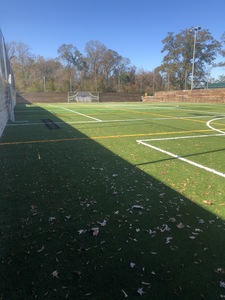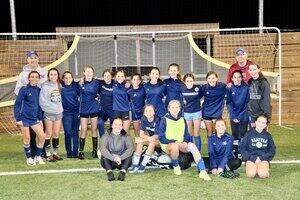Walls
Friday, January 3, 2020

One of the cooler things I get to do is camps. Somebody reads Soccer iQ and likes it enough to reach out and invite me to run a camp for their team. That’s how this story starts: A hand surgeon/soccer coach in Louisiana found my books. Read them, liked them. Turns out, his daughter was best friends with a player I coached at Ole Miss. He reached out to her, she reached out to me, and a short while later I’m spending Thanksgiving in Louisiana.
Now let me ask you this: You’re about to do a camp for a group of twelve-year-old girls in the rural outskirts of Louisiana. What level of player are you expecting to work with? Before you answer, factor in this: This team is the only competitive team in its club, the North Baton Rouge Cosmos, a club founded by Myron Emmanueal that runs a recreational soccer program catering mainly to inner-city kids. The coach never played soccer and he doesn’t cut anyone; and have I mentioned they’re from the rural outskirts of Baton Rouge? So, what do you think you’re walking into?
Yep, that’s what I thought too. Man was I wrong. Let me cut to the end of the story. It was perhaps the most enjoyable camp experience I’ve had – certainly top three. Dr. Robichaux and his wife Bonnie were impeccable hosts – the very embodiment of southern hospitality. And the players… well, the players were amazing! Not amazing for Louisiana; just plain amazing. The level of technical ability was so far above the typical U-12 team that I can’t even explain it. I couldn’t tell you who the worst player was, but even she was still pretty darn good.
I live in New Jersey, a not-rural state with a large player pool and a history of producing some serious soccer talent. Last spring I hooked on with a local club and coached a team at this same age group, and we did fairly well. And on my honor this team from rural soccer nowhere would have beaten us 6-0. They would have steamrolled our entire league. They were that good.
So, how does this group of kids from rural soccer nowhere get this good? The simplest answer…
Walls.
Dr. Mike Robichaux has an impressive property. Lots of acreage. He also has a passion for soccer. So years ago he built a grass soccer field in his backyard. Adjacent to the grass field is what I can only describe as an arena. It’s a beautiful turf field maybe sixty yards long by thirty-five wide. The field is surrounded on all sides by an eight-foot wall made of thick wooden beams. On the ends, not-quite-regulation-size goals are built directly into the walls. Above the walls are nets to catch misfires. And oh yeah, both fields have lights.
There’s no seating at this arena. It’s sort of like a free standing hockey rink. And when you step through the thick wooden door, you’re immediately on the turf. It’s like stepping into soccer’s Thunderdome.
One of the difficult things about developing as a soccer player is that the sport isn’t conducive to training alone. If you want to train as a basketball player, all you need is one ball and a goal. You dribble around a bit, take your shot, and the ball either goes through the net or it hits the rim or the backboard. At worse, you throw up an airball. Regardless, you never have to go very far to chase the ball and half the time it just comes right back to you. You can take dozens of shots in a very short period of time. Soccer… notsomuch.
If you go out to the soccer field with one ball and you decide to shoot, chances are you’re going to shoot from somewhere around the top of the eighteen. So if you shoot and miss, you’ve got to chase the ball. Now you’ve got the eighteen yards to the endline, then the forty yards behind the endline where the ball finally died, then you get the ball and run those same fifty-eight yards back. And after all that, you’re now ready to take your second shot. Even when the ball goes into the goal you still have to cover the ground to dig it out of the net. Training on your own as a soccer player can flat out suck. Believe me, I did plenty of it. I know.
Don’t get me wrong, there are other things to train besides shooting. But who wants to go to the field and not shoot? Nobody! Everybody wants to shoot. Everybody wants to imagine themselves scoring that goal. You don’t take a ball out to the field and not shoot. So what do you do? You shoot until you’re tired of chasing. And that doesn’t take too long.
I don’t want you to get hung up on the term ‘shooting.’ Unlike basketball, where the only time you would use your shooting technique is to, you know, shoot, soccer’s shooting techniques have far more applications. You use those same techniques to deliver the ball to your teammates over a variety of distances and heights. Shooting and passing are interchangeable. What I’m specifically talking about here is the driven ball. The ability to drive the ball with your laces is essential to the development of a soccer player, and when you’re training alone, if you’re going to drive the ball, there’s no point in driving it anywhere else but the goal. So shooting at a goal develops a technique that will have many other uses. Still with me? Good.
For most teams, before training officially commences, kids pair up, stand about eight yards apart and zombie pass back and forth with the inside of their feet. When Dr. Robichaux’s players arrive to the arena, they start smackin’ balls off the walls. One of the first things I noticed about his players was that they could all leather the crap out of the ball, and many of them with both feet. And you know why? Because those walls provide them with infinite reps. Everywhere they turn there’s a wall waiting to have a ball smacked off it. So they get lots of practice driving balls. And guess what… every time a player drives a ball against a wall, the wall sends the ball right back to her, so now she gets a rep receiving. And the wall’s return pass isn’t a soft roller; it’s a bouncing ball that requires a surface choice and then some degree of technical execution. Everywhere you look there’s a kid drilling a ball into the wall and then receiving the wall’s return pass.
I’m wondering if there’s someone reading this thinking, ‘So these kids can all drill a ball. So what? There’s a lot more to soccer than that!’ Yes. Yes there is more, and believe me, these kids have much more. But here’s the thing… if you’ve coached girls’ soccer at almost any level, you understand what a deficiency we have with this particular technique. Get a high school team together and see what percentage of the players can drive a straight, flighted ball over thirty yards. It’ll be less than half. The ability to drive a ball is critical, and too many players just don’t have it. These kids do, and they won’t even reach high school for another year and a half.
As if the arena walls weren’t enough, Dr. Robichaux has built three ‘battle rooms’. These tunnels are roughly fifteen yards long, eight yards wide and eight yards high, and they extend out like fingers from the arena’s exterior wall. You can think of them as wooden racquetball courts. Before training commences, without prompting, players will pair up for games of wall-ball in the battle rooms. Again there is the constant repetition of hitting and receiving the ball, and in the battle rooms, most of the time they’re hitting volleys – another technique largely deficient in the women’s game.
In case you glossed over that last part, no one is telling these kids to go into the battle rooms. They get to training early specifically because they want to use the battle rooms. Of course they do! It’s fun! The whole place is super fun! It’s a super fun soccer fun zone.
Dr. Robichaux drives his players. He drives them to focus. He drives them to execute. He demands their very best effort. And that certainly shows up in their approach to training. These kids are soccer junkies. They are sponges for new knowledge, new techniques. They show up to soccer not because it’s where they’re supposed to be; they show up because they LOVE it. But it’s that combination of Dr. Robichaux’s leadership and this soccer fun park that he’s constructed that has created an environment where players from rural soccer nowhere are more technically advanced than most of their peer group in this country.
This guy’s backyard should be the model for US Soccer. If you don’t believe me, consider this: Dr. Robichaux’s team, the Cosmos – the team from a rural area of a rural state that doesn’t make cuts… this team’s players comprise 50% of the roster for the Louisiana state team at that age group. Half! Half of the best players in the state are from this one team that isn’t located in New Orleans or Baton Rouge and has a hand surgeon for a coach. Do you think maybe they’re onto something? I’ve been doing this for a long time and if there is a soccer Promised Land, this place is it. And I’ll tell you something else: Don’t be surprised when, a few years down the road, two or three of these kids are competing for a spot on the national team.
Dr. Robichaux’s players probably get ten times the amount of touches per training session as your players or mine. No wonder they’re so freaking good. They are always striking and receiving, striking and receiving, striking and receiving. And because the arena keeps soccer fun, the kids are excited to show up. So much so that three of them – three twelve-year-old girls – will go train extra, two or three times a week, voluntarily, at five-thirty, you read that right, five-thirty, a.m. So I’ll ask you again: Do you think they’re onto something?
The camp was amazing! It was amazing because the kids were amazing. And the kids were amazing in both ability and spirit, in large part due to this wooden arena that eliminates soccer’s biggest logistical hurdle.
I’ve never been one of those people who think we’re only succeeding as a soccer country if we’re winning (or at least threatening to win) World Cups on the men’s side. I think soccer offers plenty of other intrinsic benefits that don’t involve the country’s best twenty-five players. I am, however, a big fan of the technical development of youth players for a multitude of reasons, not the least of which is my job to coach some of them when they get to college. But even more importantly, there is something intrinsically good about giving players a better mastery of their craft. That’s more or less the definition of development.
We need to realize that player development isn’t proportional to, or at least dependent upon, population. If it was, China, India, Pakistan and the US would all be world soccer powers, Iceland wouldn’t be advancing to the quarter-finals of the Euros, and these players from rural Louisiana wouldn’t be so darn good. The root of soccer development is touches on the ball. So... how do we give that to our players?
Well… I’m thinkin’ we might want to start with walls.
If you enjoyed this post, I hope you’ll consider reading one of my other books. This team from Louisiana that won my heart used Everything Your Coach Never Told You Because You’re a Girl for book study. Might be worth checkin' out.

